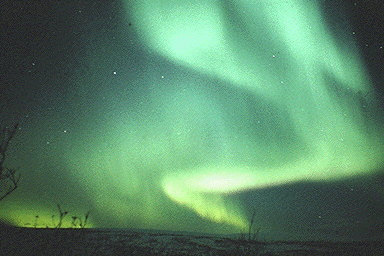 |
The sun has a number of holes in its corona from which high energy particles stream out with enormous velocity. These particles are thrown out through our solar system, and the phenomena is called solar wind. Some of this solar wind meets the earth's magneto sphere, compressing it on the daylight side, while drawing it out in a tail on the nighttime side. From out in the magnetic the solar wind particles are accelerated down to the earth again along the open magnetic field lines. The field lines are open only in the polar regions. At lower altitudes the field is locked. That is why Northern Lights only occur in the polar regions. When the solar wind particles collide with the air molecules, their energy is transferred into light. It is billions of such processes occurring simultaneously that produces the Northern Lights |
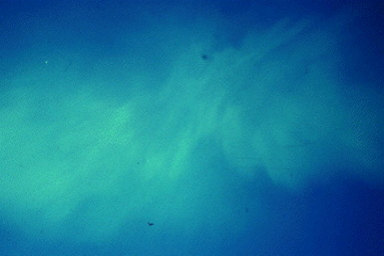 |
Since time immemorial, through different cultures and whenever they occur, there have been many beliefs about the Northern Lights. The Inuit around Hudson Bay had the following explanation of what they saw: The sky is a huge dome of hard material arched over the flat earth. On the outside there is light. In the dome there are a large number of small holes, and through these holes you can see the light from the outside when it is dark. Through these holes the spirits of the dead can pass into the heavenly regions. The way to heaven leads over a narrow bridge which spans an enormous abyss. The spirits that were already in heaven light torches to guide the feet of the new arrivals. These torches are called the Northern Lights |
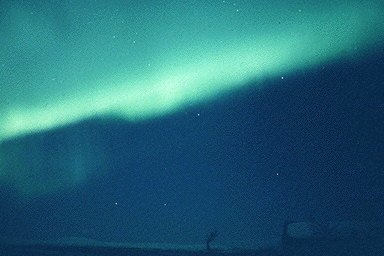 |
In Middle-Age Europe, the Northern Lights were thought to be reflections of heavenly warriors. As a kind of posthumous reward, the soldiers that gave their lives for their king and country were allowed to battle on the skies forever. The Northern Lights were the breath of these brave soldiers as they resumed their fight in the skies. Otherwise the Northern Lights were an omen. They warned of illness, plague and death. When red, which is the most common color at low altitudes, they signaled the outbreak of war.
|
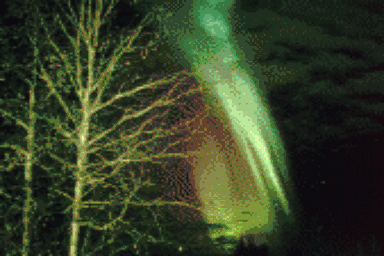 |
In Northern Norway the people's conceptions were more characterized by awe for this mighty phenomenon. Believing one should tread carefully and in no way should the Northern Lights be intimidated by waving, whistling, stared at or any other form of defiance. |
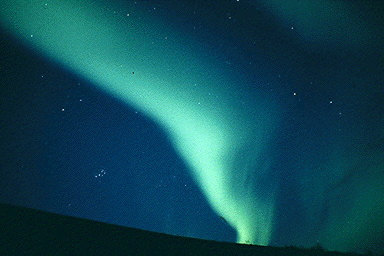 |
Already several centuries before Christ, detailed descriptions and explanations were put forward. In his book Metereologia, Aristotle's described the Northern Lights as a light which resembled the flames of burning gas. If these flames spread and at the same time sent out sparks and rays, they were called jumping goats. Without such rays, they were called simply fire. |
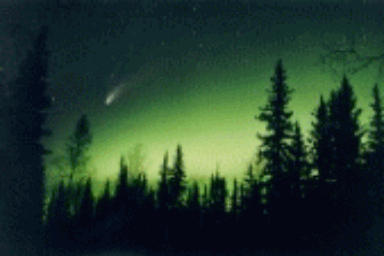 |
In Kongespeilet (The King's Mirror) written approximately 1230. Here the author writes: Otherwise it is the same with the Northern Lights as with anything else we know nothing about, that wise men put forward ideas and simple guesswork, and believe that what is most common and probable. He then puts forwards several theories, some of which are based upon the fact that the Northern Lights were then common over Greenland, but rare over Norway. For example, some people say that when the sun is under the horizon at night, some rays of light reach up to the skies over Greenland, a land mass so close to the edge of the earth that the earth's curvature which hides the sun must be less there. |
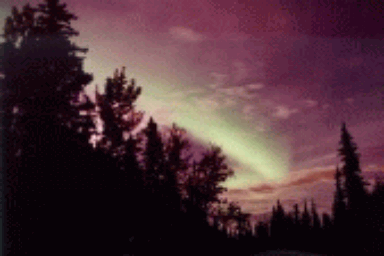 |
Even today there are many different theories about the Northern Lights. Some say that if you wave to them, they will increase in activity or even reach down and catch you. Or that if you look at them you will damage your eyes. One common notion is that the lights only appear when it is cold. They are, of course unaffected by the weather, but to see them, it should be a dark and cloudless sky. |
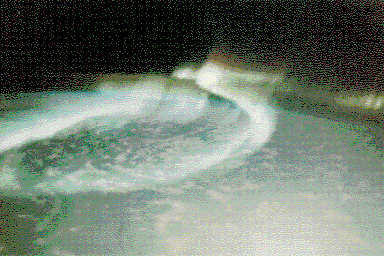 |
Some things in life are such a visual experience that words never are adequate to describe the encountering. To look up into the heavens on a night and see the performance of light dancing as it spreads across the horizon as far as the eye can see, creates a mystic feeling of awe. See it once and forever you will look up at a night sky in hopes you will be once more entertained by this spectacle. Cheryl C. Helynck 1999 |